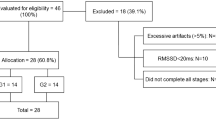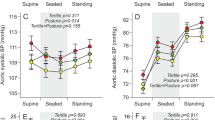Abstract
Fetal growth retardation has been linked to elevated blood pressure in adult life. This association between birth weight and blood pressure is present in childhood and is amplified with age. However, the mechanisms that underlie this association are largely unknown. We examined the relationship between birth weight and forearm vascular resistance and forearm blood flow in children aged 9–12.7 years. A total of 58 children were randomly selected from a cohort of 1610 born at the University Hospital of the West Indies in Jamaica where adequate antenatal and delivery records were available. Blood pressure, heart rate and forearm blood flow (by venous occlusion plethysmography) were measured at rest and after cold pressor and mental arithmetic tests. There was a significant inverse correlation between birth weight and the change in the vascular resistance for the cold pressor test (r=−0.47; P<0.001) and the mental arithmetic stress test (r=−0.26; P=0.05). The log ratio of vascular resistance under stress to resting decreased by 0.289 units per kg of birth weight (95% CI: 0.145–0.434; P=0.0002). Lower birth weight is associated with increased vascular responsiveness. Increased vascular resistance might be one mechanism linking fetal growth to subsequent elevated blood pressure.
This is a preview of subscription content, access via your institution
Access options
Subscribe to this journal
Receive 12 digital issues and online access to articles
$119.00 per year
only $9.92 per issue
Buy this article
- Purchase on Springer Link
- Instant access to full article PDF
Prices may be subject to local taxes which are calculated during checkout

Similar content being viewed by others
References
Cooper R et al. The prevalence of hypertension in seven populations of west African origin. Am J Public Health 1997; 87: 160–168.
Huxley RR, Shiell AW, Law CM . The role of size at birth and postnatal catch-up growth in determining systolic blood pressure: a systematic review of the literature. J Hypertens 2000; 18: 815–831.
Law CM et al. Initiation of hypertension in utero and its amplification throughout life. BMJ 1993; 306: 24–27.
Folkow B . Cardiovascular structural adaptation; its role in the initiation and maintenance of primary hypertension. Clin Sci Mol Med 1978; 55: 3S–22S.
Forrester TE et al. Fetal growth and cardiovascular risk factors in Jamaican schoolchildren. BMJ 1996; 312: 156–160.
Elia M, Kurpad A . What is the blood flow to resting human muscle? Clin Sci (London) 1993; 84: 559–563.
Journo HJ et al. Hysteresis of the venous pressure–volume relationship in the forearm of borderline hypertensive subjects. Clin Sci (London) 1992; 82: 329–334.
Whitney R . The measurement of volume changes in human limbs. J Physiol (London) 1953; 121: 1–27.
Savage MV, Brengelmann GL . Reproducibility of the vascular response to heating in human skin. J Appl Physiol 1994; 76: 1759–1763.
Utriainen T et al. Methodological aspects, dose–response characteristics and causes of interindividual variation in insulin stimulation of limb blood flow in normal subjects. Diabetologia 1995; 38: 555–564.
Lenders J et al. Role of the wrist cuff in forearm plethysmography. Clin Sci (London) 1991; 80: 413–417.
Johnson EH et al. Similarities in cardiovascular reactivity to behavioral stressors in African-American and white males. Ethn Dis 1992; 2: 232–245.
Frank SM, Raja SN . Reflex cutaneous vasoconstriction during cold pressor test is mediated through alpha-adrenoceptors. Clin Auton Res 1994; 4: 257–261.
Julius S, Conway J . Hemodynamic studies in patients with borderline blood pressure elevation. Circulation 1968; 38: 282–288.
Lund-Johansen P . Haemodynamics in essential hypertension. Clin Sci (London) 1980; 59(Suppl 6): 343s–354s.
Julius S, Majahalme S . The changing face of sympathetic overactivity in hypertension. Ann Med 2000; 32: 365–370.
Folkow B . Physiological aspects of primary hypertension. Physiol Rev 1982; 62: 347–504.
Hinderliter AL et al. Ethnic differences in forearm vasodilator capacity. Am J Cardiol 1996; 78: 208–211.
Lindqvist M et al. Sustained forearm vasodilation in humans during mental stress is not neurogenically mediated. Acta Physiol Scand 1996; 158: 7–14.
Wladimiroff JW et al. Cerebral and umbilical arterial blood flow velocity waveforms in normal and growth-retarded pregnancies. Obstet Gynecol 1987; 69: 705–709.
al-Ghazali W et al. Evidence of redistribution of cardiac output in asymmetrical growth retardation. Br J Obstet Gynaecol 1989; 96: 697–704.
Arduini D, Rizzo G . Fetal renal artery velocity waveforms and amniotic fluid volume in growth-retarded and post-term fetuses. Obstet Gynecol 1991; 77: 370–373.
Jouppila P, Kirkinen P . Increased vascular resistance in the descending aorta of the human fetus in hypoxia. Br J Obstet Gynaecol 1984; 91: 853–856.
Hecher K et al. Assessment of fetal compromise by Doppler ultrasound investigation of the fetal circulation. Arterial, intracardiac, and venous blood flow velocity studies. Circulation 1995; 91: 129–138.
Leeson CP et al. Flow-mediated dilation in 9- to 11-year-old children: the influence of intrauterine and childhood factors. Circulation 1997; 96: 2233–2238.
Martin H et al. Impaired endothelial function and increased carotid stiffness in 9-year-old children with low birthweight. Circulation 2000; 102: 2739–2744.
Sarkar R, Webb RC . Does nitric oxide regulate smooth muscle cell proliferation? A critical appraisal. J Vasc Res 1998; 35: 135–142.
Lever AF, Harrap SB . Essential hypertension: a disorder of growth with origins in childhood? J Hypertens 1992; 10: 101–120.
Goodfellow J et al. Endothelial function is impaired in fit young adults of low birth weight. Cardiovasc Res 1998; 40: 600–606.
Martyn CN et al. Growth in utero, adult blood pressure, and arterial compliance. Br Heart J 1995; 73: 116–121.
Lurbe E et al. Birth weight impacts on wave reflections in children and adolescents. Hypertension 2003; 41: 646–650.
Vijayakumar M et al. Birth weight, weight at one year, and left ventricular mass in adult life. Br Heart J 1995; 73: 363–367.
Montgomery AA et al. Birth size and arterial compliance in young adults. Lancet 2000; 355: 2136–2137.
Singhal A et al. Preterm birth, vascular function, and risk factors for atherosclerosis. Lancet 2001; 358: 1159–1160.
Kumaran K et al. Blood pressure, arterial compliance, and left ventricular mass: no relation to small size at birth in south Indian adults. Heart 2000; 83: 272–277.
Cheung YF et al. Relation of arterial stiffness with gestational age and birth weight. Arch Dis Child 2004; 89: 217–221.
Norman M, Martin H . Preterm birth attenuates association between low birth weight and endothelial dysfunction. Circulation 2003; 108: 996–1001.
Oren A et al. Gestational age and birth weight in relation to aortic stiffness in healthy young adults: two separate mechanisms? Am J Hypertens 2003; 16: 76–79.
Author information
Authors and Affiliations
Corresponding author
Rights and permissions
About this article
Cite this article
Nichols, S., Boyne, M., Thame, M. et al. Cold-induced elevation of forearm vascular resistance is inversely related to birth weight. J Hum Hypertens 19, 309–314 (2005). https://doi.org/10.1038/sj.jhh.1001826
Received:
Revised:
Accepted:
Published:
Issue Date:
DOI: https://doi.org/10.1038/sj.jhh.1001826



